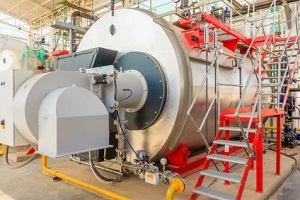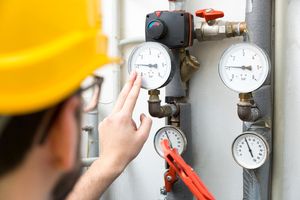 A steam boiler is an important piece of equipment for many industrial and commercial facilities. It is essential that those who operate and maintain these boilers understand how to do so properly in order to ensure safe and efficient operation.
A steam boiler is an important piece of equipment for many industrial and commercial facilities. It is essential that those who operate and maintain these boilers understand how to do so properly in order to ensure safe and efficient operation.
Understanding how the pros operate and maintain steam boilers can help you ensure that you don’t miss out on key tips that can help you avoid paying the price down the road.
Tips for Proper Steam Boiler Operation
In order to ensure your steam boilers run safely and efficiently, there are a few maintenance tasks to complete on a regular basis. Improper operation can lead to a decreased lifespan of the boiler, increased energy costs, and potential costly repairs. Here are some important tips to keep in mind:
Maintain Proper Water Levels
It is critical to maintain proper water levels in a boiler to prevent failure. This can be difficult for a steam boiler plant as water needs to be added when steam is drawn off. Balancing your water levels is important because having too much or too little can have negative effects.
Adding too much water can lower the temperature inside the boiler, thus requiring more energy to produce steam. Too much water can also increase pressure inside of your boiler as steam is generated, which can put a strain on your valves and fittings.
If the water level falls too low, the boiler and its components can overheat. The heated tubes need to remain submerged. If the water level gets low enough this can lead to system failure as the boiler is firing with no water to heat. You can automate your water levels to ensure they are in balance but make sure to also regularly check your sight glass.
Maintain Proper Feed Water Temperatures
Most boilers use a feedwater heater which reuses steam extracted from the turbine in order to preheat water that is about to enter the boiler for new steam generation. The purpose of this is to maintain the efficiency and longevity of the system.
 Preheating reduces how much time and fuel is consumed in producing steam by raising the initial temperature. The lower the temperature of the water entering the system, the longer and harder the system has to work.
Preheating reduces how much time and fuel is consumed in producing steam by raising the initial temperature. The lower the temperature of the water entering the system, the longer and harder the system has to work.
Streamlining the time and energy needed to create steam reduces fuel costs and emissions, which creates for an efficient plant. Maintaining the temperature of your feedwater also helps to minimize thermal stress.
Metal expands and contracts depending on the temperatures it is exposed to. Preheating your water and maintaining the proper temperature reduces the chance of your boiler cracking. Raising your water temperature will also remove any oxygen from the water prior to it entering your system. Deaeration will help reduce pitting within the boiler.
Proper Water Treatment
It is important to treat the feedwater entering your boiler in order to efficiently produce quality steam and ensure continuous heat exchange. Treatment will also provide for protection against corrosion and scaling which improves output and extends the life of the system.
The purpose of the feedwater treatment is to remove dissolved solids and dissolved gasses from the water which can create scaling, or even pitting inside the boiler when steam is generated. When water is converted to steam, dissolved minerals will build up on the surfaces within the system and over time accumulate into scaling if not treated.
This can reduce the efficiency of heat exchange and cause your system to work harder to achieve the desired temperature. High concentrations of dissolved solids will also cause foaming which will create deposits within components like the boiler valves and turbine.
Corrosion and thinning can also occur if the water is not treated to remove oxygen. Over time pitting will lead to a costly replacement of the system. Speak with a professional about a feedwater treatment program to increase the lifespan of your boiler, and keep your plant running efficiently.
Switch the Boiler From Lead to Lag Daily
Most building boiler systems are set up to have two or more boilers in line on a lead and lag system to handle high demand during colder months. The building engineer will designate one boiler to be the lead, or primary, and the other to be the lag or secondary.
 A lead-lag configuration is used for energy savings so that your secondary boiler is only turning on when demand surpasses what the lead boiler can handle. This prevents both boilers from running simultaneously and burning fuel if the building does not require it to.
A lead-lag configuration is used for energy savings so that your secondary boiler is only turning on when demand surpasses what the lead boiler can handle. This prevents both boilers from running simultaneously and burning fuel if the building does not require it to.
It is important to alternate the lead boiler so that wear and tear is distributed. If you do not switch your boilers between lead and lag, one boiler will be overloaded while the other is on standby. Swapping your boilers on a regular basis will also keep your water treatment fresh across the entire system.
Ensure the Furnace Is Clean
If there is too much soot or ash buildup in the furnace, it can impair the ability of the boiler to generate heat, leading to inefficient operation.
Dirty filters and other obstructions can reduce airflow and cause the furnace to work harder than necessary, leading to increased energy consumption and possible damage to the unit. Furnace maintenance includes regularly changing the filter, cleaning the blower assembly and burner box, and checking for cracks or leaks in the heat exchanger.
Maximize Efficiency and Durability With Proper Steam Boiler Operation
Operating a steam boiler at peak efficiency is critical to ensure that the system runs smoothly and produces the desired output. In order to do so, it is important to properly maintain the boiler by following a few simple guidelines. You can improve the lifespan of your steam boiler and avoid costly repairs or shutdowns if you understand these best practices.
If you need assistance with the operation or maintenance of your steam boiler, reach out to our team of experts today at 212-518-6475!
